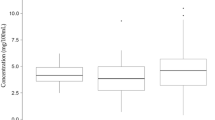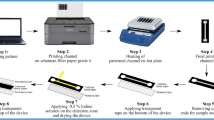Abstract
Milk is a complex raw material, and it requires a strict quality control. The analyses that milk undergoes upon its arrival to the dairy industry are essential for its quality control. However, some of these analyses are complex; expensive; and in some cases, subjective, such as the detection of sub-clinical mastitis. With that in mind, a portable device was developed with the objective to create a fast, accurate, and easy-to-use tool for the detection of mastitis and for the evaluation of the overall quality of milk. Samples of bovine raw milk were evaluated for acidity, composition, somatic cell count (SCC), and electrical conductivity, coupled with gas sensor MQ-135, responsible for detecting carbon dioxide and ammonium, and gas sensor MQ-3, responsible for detecting ethanol, benzene, methane, hexane, and carbon monoxide. Through the MQ-135 measurement, it was possible to determine the occurrence of mastitis milk with a 77% accuracy, while MQ-3 did not show promising results. Besides, it was also possible to estimate acidity, lactose, protein, ashes, and casein content with the use of our portable device, with a satisfactory level of accuracy when milk components were found within their normal range of variation. The sensor device developed shows potential to provide a fast decision-making tool in the dairy industry.





Similar content being viewed by others
References
Association of Official Analytical Chemists - AOAC (1990). Official methods of analysis of international. 15 ed. Washington DC.
Association of Official Analytical Chemists - AOAC (2000). Official methods of analysis of international. 17 ed. Washington DC.
Bansal, B. K., Hamann, J., Grabowski, N. T., & Singh, K. B. (2005). Variation in the composition of selected milk fraction samples from healthy and mastitic quarters, and its significance for mastitis diagnosis. Journal of Dairy Research, 72(1), 144–152. https://doi.org/10.1017/S0022029905000798.
Brouk, M. J., Cvetkovic, B., Rice, D. W., Smith, B. L., Hinds, M. A., & Owens, F. N. (2011). Performance of lactating dairy cows fed corn as whole plant silage and grain produced from genetically modified corn containing event DAS-59122-7 compared to a nontransgenic near-isogenic control. Journal of Dairy Science, 94(4), 1961–1966. https://doi.org/10.3168/jds.2010-3477.
Chen, B., Lewis, M., & Grandison, A. (2014). Effect of seasonal variation on the composition and properties of raw milk destined for processing in the UK. Food Chemistry, 158(1), 216–223. https://doi.org/10.1016/j.foodchem.2014.02.118.
Eriksson, A., Waller, K. P., Svennersten-Sjaunja, K., Haugen, J.-E., Lundby, F., & Lind, O. (2005). Detection of mastitic milk using a gas-sensor array system (electronic nose). International Dairy Journal, 15(1), 1193–1201. https://doi.org/10.1016/j.idairyj.2004.12.012.
Fourie, C.J., Van Der Westhuyzen P.J., & Van Niekerk P.C. (2007). An automated system for impedance measurements in milk. AFRICON 2007. IEEE.
Fröhling, A., Wienke, M., Rose-Meirhofer, S., & Schluter, O. (2010). Improved method for mastitis detection and evaluation of disinfectant efficiency during milking process. Food and Bioprocess Technology, 3(1), 892–900. https://doi.org/10.1007/s11947-010-0366-9.
Hauke, J., & Kossowski, T. (2011). Comparison of values of Pearson’s and Spearman’s correlation coefficient on the same sets of data. Quaestiones Geographicae, 30(2), 87–93.
Hettinga, K. A. (2008). Quality control of raw cow's milk by headspace analysis. International Dairy Journal, 18(5), 506–513. https://doi.org/10.1016/j.idairyj.2007.10.005.
Hettinga, K. A., van Valenberg, H. J. F., Lam, T. J. G. M., & van Hooijdonk, A. C. M. (2009). The origin of the volatile metabolites found in mastitis milk. Veterinary Microbiology, 137(3–4), 384–387. https://doi.org/10.1016/j.vetmic.2009.01.016.
Inalpulat, M., Kizil, Ü., Bilgücü, E., & Genç, L. (2016). E-nose identification of milk somatic cell count. Journal of Graduate School of Natural and Applied Sciences, 2(1), 22–35.
Kessels, J. A., Cha, E., Johnson, S. K., Welcome, F. L., Kristensen, A. R., & Gröhn, Y. T. (2016). Economic comparison of common treatment protocols and J5 vaccination for clinical mastitis in dairy herds using optimized culling decisions. Journal of Dairy Science, 99(5), 3838–3847. https://doi.org/10.3168/jds.2015-10385.
Khatun, M., Clark, C. E. F., Lyons, N. A., Thomson, P. C., Kerrisk, K. L., & García, S. C. (2017). Early detection of clinical mastitis from electrical conductivity data in an automatic milking system. Animal Production Science, 57(7), 1226–1232. https://doi.org/10.1071/AN16707.
Kutner, M. H., Nachtsheim, C. J., Neter, J., & Li, W. (2005). Applied linear statistical model. Chicago, IL: McGraw-Hill/Irwin.
Le Maréchal, C., Hernandez, D., Schrenzel, J., Even, S., Berkova, N., Thiery, R., Vautor, E., Fitzgerald, J. R., Francois, P., Le Loir, Y. (2011). Genome sequences of two staphylococcus aureus ovine strains that induce severe (Strain O11) and mild (Strain O46) mastitis. Journal of Bacteriology, 193(9), 2353–2354.
Lien, C.-C., Wan, Y.-N., & Ting, C.-H. (2016). Online detection of dairy cow subclinical mastitis using electrical conductivity indices of milk. Engineering in Agriculture, Environment and Food, 9(3), 201–207. https://doi.org/10.1016/j.eaef.2015.12.002.
Longo, R. M., Ferreira, L. F., Feijo, F. D. A. C., Conrrado, R. S., Costa, M. E. R., & Cerqueira, M. M. O. P. (2016). Lipolysis effect on milk fat and protein analysis by infrared spectroscopy using filter and Fourier transform infrared (FTIR) methods. Journal of Animal Science, 94(1), 267–267. https://doi.org/10.2527/jam2016-0561.
Machado, S. C., Fischer, V., Stumpf, M. T., & Stivanin, S. C. B. (2017). Seasonal variation, method of determination of bovine milk stability, and its relation with physical, chemical, and sanitary characteristics of raw milk. Revista Brasileira de Zootecnica, 46(4), 340–347. https://doi.org/10.1590/s1806-92902017000400010.
Mekibib, B., Furgasa, M., Abunna, F., Megersa, B., & Regassa, A. (2010). Bovine mastitis: prevalence, risk factors and major pathogens in dairy farms of Holeta town, Central Ethiopia. Veterinary World, 3(9), 397–403. https://doi.org/10.5455/vetworld.2010.397-403.
Press, W., Flannery, B., Teukolsky, S., Vetterling, W. (2007). Numerical recipes. In: Fortran numerical recipes: the art of scientific computing, vol. 1, Cambridge University press, 1992.
Pyorala, S. (2003). Indicators of inflammation in the diagnosis of mastitis. Veterinary Research, 34(1), 565–578. https://doi.org/10.1051/vetres:2003026.
Reinemann, D.J., & Helgren, J.M. (2004). Online milk sensing issues for automatic milking. 2004 ASAE/CSAE annual international meeting, Ottawa, Ontario, Canada, paper number 04-4191.
Ribeiro, A. B. C., Santos, J. S., Zanol, D., Lombarde, L. N. L., Bruzaroski, S. R., Ludovico, A., & Santana, E. H. W. (2016). Evaluation of an electrical conductivity portable device as an alternative for subclinical mastitis detection. Revista de Salud Animal, 38(2), 131–135.
Ross, S. M. (2012). A first course in probability. Upper Saddle River: Pearson Prentice Hall.
Santos, A. L., Pires, A. C. S., Behaine, J. J., Araújo, E. A., Andrade, N. J., & Carvalho, A. F. (2013). Effect of cleaning treatment on adhesion of Streptococcus agalactiae to milking machine surfaces. Food and Bioprocess Technology, 6(7), 1868–1872.
Schwarz, D., Diesterbeck, U. S., Failing, K., König, S., Brügemann, K., & Zschöck, M. (2010). Somatic cell counts and bacteriological status in quarter foremilk samples of cows in Hesse, Germany—a longitudinal study. Journal of Dairy Science, 93(12), 5716–5728. https://doi.org/10.3168/jds.2010-3223.
Walstra, P., Wouters, J. T. M., & Geurts, T. J. (2006). Dairy science and technology. Boca Raton: CRC Press.
Funding
The authors thank Conselho Nacional de Desenvolvimento Científico e Tecnológico (CNPq) and Fundação de Amparo à Pesquisa do Estado de Minas Gerais (FAPEMIG) for the financial support.
Author information
Authors and Affiliations
Corresponding author
Rights and permissions
About this article
Cite this article
Lima, R.S., Danielski, G.C. & Pires, A.C.S. Mastitis Detection and Prediction of Milk Composition Using Gas Sensor and Electrical Conductivity. Food Bioprocess Technol 11, 551–560 (2018). https://doi.org/10.1007/s11947-017-2029-6
Received:
Accepted:
Published:
Issue Date:
DOI: https://doi.org/10.1007/s11947-017-2029-6




